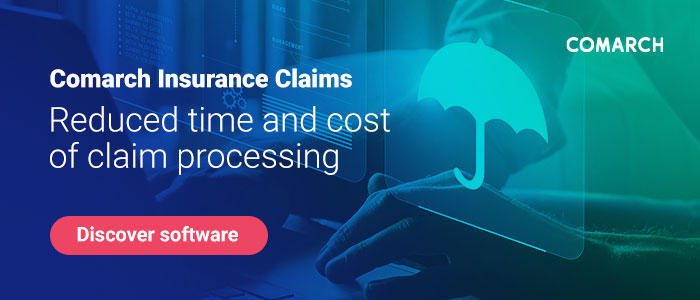Bitter-sweet claims process modernization in insurance
- Published
- 5 min reading

It's high time to act
The increased risk of weather events related to climate change, higher mortality rate due to pandemics, new competitors and growing customer expectations are just some of the many reasons why digital transformation should start primarily in the area of claims handling process in insurance. Every year, every subsequent month even, brings technological innovations in this area—inspection of property damage using drones, or automatic collision reporting by a vehicle-installed shock sensor (in IoT technology).
There are many ideas for innovations in the area of claims handling in the insurance process.
Technology in the service of claims prevention and liquidation

The use of the latest technologies such as AI (chatbots, artificial assistant, image recognition, etc.) or IoT (providing statistics on driving style for risk assessment and insurance valuation, informing about an error via a real estate water meter sensor, etc.) is possible with every insurer, even if it operates on outdated systems.
However, investing in technology like AI is not about owning it, but about exploiting the most opportunities that it brings. Legacy significantly hinders, or even completely prevents progress in those fields. The most common limitations occur in the area of collecting, analyzing, and presenting large amounts of data. The solution would be simultaneous implementation of a modern insurance system. Currently, IT providers offer various scenarios for such implementation. It is possible to implement the entire platform or just a selected module. You can start with the claims management module, which, thanks to the open infrastructure, can be easily connected to the already owned core.
Next-generation damage segmentation

Classifying the damage according to its complexity or degree of impact on profitability is no longer enough. There are going to be more and more damage reports that will require an individual approach and unconventional solutions. An example would be claims in the insurance process that affects the insurer's reputation and require special negotiations. On the other hand, catastrophic damages determine the automatic launch of specific preventive actions and clearly defined support, e.g. shifting human resources and handling notifications from such events in the first place.
Claims validation process is strongly related to the topic of technology. Identification of the notifications that generate additional risks in the need of taking additional action requires automating the analysis of data. Such solutions are already available on the market.
Human resources

The process of modernizing claims process in insurance will also affect the organizational structure. New positions will be created, and with them, the scope of tasks to perform will change. While many process paths will be digitized and automated, manual work will take on a more supervisory character (e.g. handling the complaint process, etc.). It may also turn out that other skills and qualifications will be expected from employees, like data analysis, product, process and project managements. The priority will be to attract and retain specialists and talents.
Customer in focus

In the book “Marketing 5.0”, Kotler, Kartajaya and Setiawan notice that for the first time in history, as many as five generations of people coexist in the world at the same time, each with distinctive needs and behaviors.
In their article “Claims 2030: Dream or reality?”, McKinsey enlist the generational differences. On the one hand, there are the Millennials and the Gen Z, who expect seamless, multi-channel service and real-time interaction on their everyday platforms. On the other hand, there are older customers with less experience in this area—the Gen X and the Baby Boomers—that are having more difficulties with digital solutions and expect to be able to reach a real person to assist them.
This raises some challenges in service, that can be overcome thanks to modern claims systems and processes. It’s now possible, for example, to report a claim to the call center, and then track its status in the app.
Partnerships

The use of solutions such as smart home, or life function controllers in insurance processes requires cooperation with external companies. Some are quite simple to implement, but they all need integration with existing claims systems to process all the collected data. This will be a problem for legacy systems. It can therefore be said that partnerships, as well as building new value for customers thanks to those partnerships, may be questioned not for legal or organizational reasons, but primarily due to technological limitations and the required involvement of the IT department.
Efficiency

What has before been dependent on the work of human hands, will be performed by machines, to varying degrees. However, the overriding goal of modernizing the claims handling process in insurance is not so much the digitization as, above all, the automation that is able to simplify paths and shorten their processing time, saving money as a result. For example, modern claims systems enable the process of automatic claims validation, auto-complete data in notifications, and appropriate queuing. Finally, the process as well as its individual components can be tested for their effectiveness.
Benefits

Modernization of the claims handling insurance process affects the entire organization, to a greater or lesser extent. Such changes take time and commitment, but IT suppliers are able to skillfully adjust the scope and time of the project to the needs and capabilities of the client. The benefits implementations like that can be seen within a few weeks, especially when an experienced IT supplier is able to divide the project in such a way that new processes or functions in subsequent phases can be launched and gain business value as soon as possible, even before the entire project is completed.
The most important benefits of modernizing the claims handling insurance process are:
- digitization and automation of processes that were previously performed manually,
- saving time and money,
- better customer, employee, and sales force experience,
- higher flexibility to changes in legislation and on the market,
- the possibility of constant control of process efficiency.
Modernizing the claims system can be long and tedious, or—with the help of an experienced IT provider—efficient and profitable faster than you could imagine. This undoubtably requires the investment of certain resources, but much less if you use ready-made solutions offered by suppliers. Success is even more certain when the solutions have been tested by other insurers. There may be some doubts, but there are some unquestionable benefits at the same time.

Product Marketing Manager at Comarch
